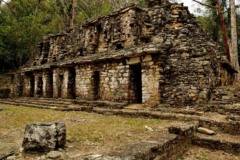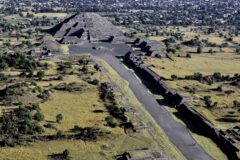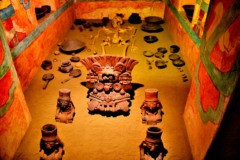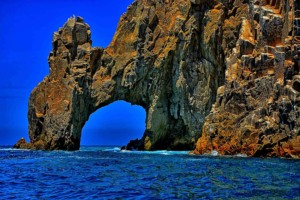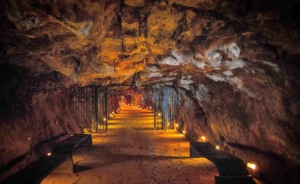Chichen Itza is a renowned archaeological site located on the Yucatan Peninsula of Mexico. It represents one of the most iconic and well-preserved pre-Hispanic cities of the Maya civilization. Here’s a summary of Chichen Itza’s historical and cultural significance:
Chichen Itza Facts and History
1. Historical Significance: Chichen Itza was a prominent city of the Maya civilization, believed to have been established around 600 AD. It served as a political, economic, and cultural hub for the Maya people on the Yucatan Peninsula. The city’s name, “Chichen Itza,” is derived from the Maya words “Chi” (mouth), “chen” (well), and “Itza” (the name of the tribe that inhabited the area).
2. Architectural Marvels: Chichen Itza is celebrated for its remarkable architecture, featuring a blend of Maya and Toltec styles. One of its most iconic structures is El Castillo, also known as the Pyramid of Kukulkan. This pyramid showcases advanced astronomical and mathematical knowledge, with its design aligning with the equinoxes to create a serpent-like shadow descending the pyramid’s steps.
3. Sacred Cenote: The city is home to the Sacred Cenote, a natural sinkhole believed to have held religious significance. It was used for ceremonial purposes, including offerings of valuable objects, jewelry, and even human sacrifices. Explorations of the cenote have revealed a trove of archaeological artifacts.
4. Maya Calendar and Mathematics: Chichen Itza’s observatory, known as the Caracol, demonstrates the Maya’s advanced understanding of astronomy. The city’s architecture also incorporates precise mathematical and calendrical calculations, evident in the layout of buildings and structures.
5. Cultural Center: Chichen Itza played a pivotal role in disseminating Maya culture throughout Mesoamerica. The city was a center of learning, religion, and trade, attracting people from various regions. Its influence extended far beyond its immediate borders.
6. Pre-Hispanic City of Chichen-Itza: In 1988, Chichen Itza was designated as a UNESCO World Heritage Site, recognizing its cultural and historical significance on a global scale. It is also considered one of the New Seven Wonders of the World.
7. Tourist Attraction: Today, Chichen Itza is a popular tourist destination, drawing visitors from around the world to marvel at its architectural marvels, explore its rich history, and gain insights into the Maya civilization. It continues to be a symbol of ancient ingenuity and cultural heritage.
Facts About Chichen Itza
Chichen Itza stands as a testament to the intellectual and cultural achievements of the Maya civilization and serves as a link to the ancient past, offering valuable insights into their knowledge, beliefs, and way of life.
8. Mayan Construction: Chichén Itzá, believed to have been constructed by the Maya civilization in the sixth century CE, represents a remarkable archaeological site. The city’s early structures primarily follow the Puuc architectural style, distinguishing them from the styles found in the southern plains.
Key early buildings around the Main Plaza include the “Akabtzib” (House of the Dark Writing), “Chichanchob” (Red House), “Iglesia” (church), “Casa de las Monjas” (nunnery), and “El Caracol” (the snail telescope).
9. Toltec arrival: Evidence suggests that in the 10th century, outsiders, possibly influenced by the Toltecs from central Mexico, arrived at Chichén Itzá after the fall of Maya cities in the southern lowlands. The Itza people, for whom the site is named, are considered possible conquerors, although some theories propose their arrival 200–300 years later.
10. El Castillo: These newcomers played a pivotal role in constructing significant landmarks like “El Castillo” (the castle), a pyramid soaring 79 feet (24 meters) above the main square. This pyramid has four sides, each facing a cardinal direction, and is adorned with 91 steps per side, totaling 365 steps when including those on the top platform, symbolizing the solar year.
11. Mexican Pyramid: The framework of the pyramid is based on the number of days in a solar year. During the spring and fall equinoxes, the setting sun casts a shadow down the stairs, creating a snake-like effect, a tribute to the important deity Quetzalcóatl. Atop the pyramid, there is a carving of Kukulcán, a feathered serpent.
12. Mayan ball game: Excavations within the nine-platform pyramid unearthed a jade-covered red jaguar throne in an older structure. Chichén Itzá also features the largest ball court in the Americas, where the Mayan ball game “Tlachtli,” or “pok-ta-pok” in Mayan, was played. The court measures 545 feet (166 meters) in length and 223 feet (68 meters) in width.
13. Sculptures: On the court walls, there are six sculptures depicting the victorious team holding the defeated team’s head. Adjacent to the court is the Temple of the Jaguars, with a mural illustrating soldiers surrounding a settlement. Remarkably, words spoken at the temple’s north platform can be heard from 150 feet (46 meters) away.
History of Chichen Itza
Despite Chichén Itzá’s remote and abandoned state for an extended period, the Maya continued to regard it as a sacred place. In the 19th century, when excavations commenced, it emerged as one of Mexico’s most significant historical sites.
14. Founding of Chichén Itzá: Much like many facets of Mayan history, the origins of Chichén Itzá remain shrouded in obscurity due to the scarcity of written records. In the available historical accounts, the Mayan calendar’s organization often led to the assignment of identical names to years that were actually several years apart. Despite this uncertainty, there’s a general consensus that Chichén Itzá primarily functioned as a ceremonial hub for the Maya from approximately AD 550 to AD 800.
15. Abandonment: Curiously, the site was mostly abandoned for roughly a century afterward, and the reasons for this abandonment remain a mystery. It wasn’t until around AD 900 that the area was resettled. Just before AD 1000, it faced an invasion by the Toltecs, a northern people.
16. Aztec deity: The Toltecs initially settled at Tula, near present-day Mexico City, around AD 900, led by a ruler named Topiltzin. Notably, Topiltzin adopted the name Quetzalcoatl, signifying the “Feathered Serpent,” an Aztec deity. However, a rival warrior faction compelled Topiltzin Quetzalcoatl and his adherents to flee Tula around AD 987.
17. Human Sacrifice: Mayan historical sources recount that during the period concluding in AD 987, an individual who identified himself as Kukulkán arrived in Chichén Itzá from the west (Kukul translates to “feathered,” and kan means “serpent”).
A compelling argument posits that Topiltzin Quetzalcoatl and Kukulkán were likely one and the same, bringing Toltec beliefs and practices to Chichén Itzá, which encompassed the grim practice of human sacrifice. Nevertheless, the Toltecs displayed some openness to assimilating the existing Mayan beliefs and practices at Chichén Itzá.
18. Old and New Chichén Itzá: Chichén Itzá comprises two distinct areas characterized by their differing architectural styles. The older portion predates the Toltec conquest and is characterized by a unique Puuc style, named after the hilly region in southwestern Yucatan where it originated.
Key features of Puuc architecture include intricate lattice-like designs on building facades and the presence of long-hooked masks depicting the rain god Chac, which adorn the corners and sides of numerous structures. Within this zone lies the Caracol, a distinctive structure once thought to serve little purpose but now widely believed to have functioned as an observatory.
The newer sector of Chichén Itzá was erected following the arrival of the Toltecs. While Mayan monster masks are prevalent in these buildings, a substantial Toltec influence is apparent. The architecture here is adorned with depictions of Toltec dignitaries and feathered serpents.
19. Chac the Rain God: Scattered throughout Chichén Itzá are reclining stone figures clutching plate-like receptacles known as chacmools, a feature purely of Toltec origin. These may have been employed to collect the hearts of sacrificial victims offered to Chac, the rain god.
However, the most iconic structure in this area is El Castillo, also known as the Pyramid of Kukulcán (the feathered serpent god; an image of him emerges on the steps of El Castillo during the spring and fall equinoxes). During these equinoxes, the setting sun produces the illusion of a serpent descending down this edifice.
20. Decline of Chichén Itzá: Chichén Itzá’s decline began with the fall of the Toltec rule, around AD 1200, when the city was inexplicably deserted. It was subsequently resettled by the Itzá, a people known for their roles as merchants and warriors, around AD 1224. They bestowed upon the city its present name, Chichén Itzá, signifying “at the mouth of the well of the Itzá.”
These wells, referred to as cenotes, are circular sinkholes formed by the collapse of underground caves. They served as essential sources of both drinking water and irrigation. The Sacred Cenote, in particular, was likely a significant ceremonial center. Within its depths, artifacts like jade, engraved gold disks, and even human remains have been discovered, leading to the belief that it was a site for human sacrifices.
The Itzá, however, inexplicably abandoned Chichén Itzá shortly after their settlement, moving to nearby Mayapan. Mayapan later became the capital of Yucatan for about two centuries until internal conflicts led to the establishment of separate city-states. The splendor of Chichén Itzá was never again revived; only the silent structures endure, serving as reminders of its past magnificence and the sophisticated astronomical knowledge held by the Maya.

